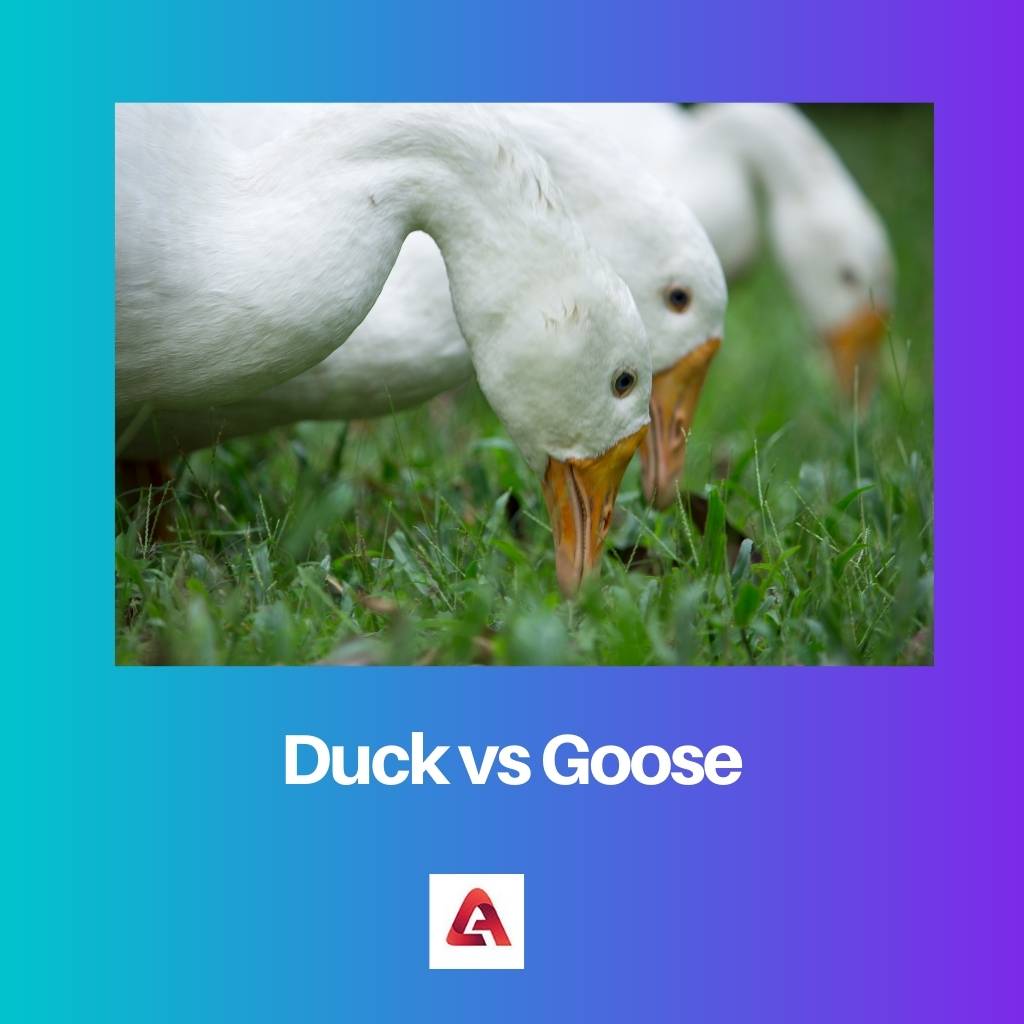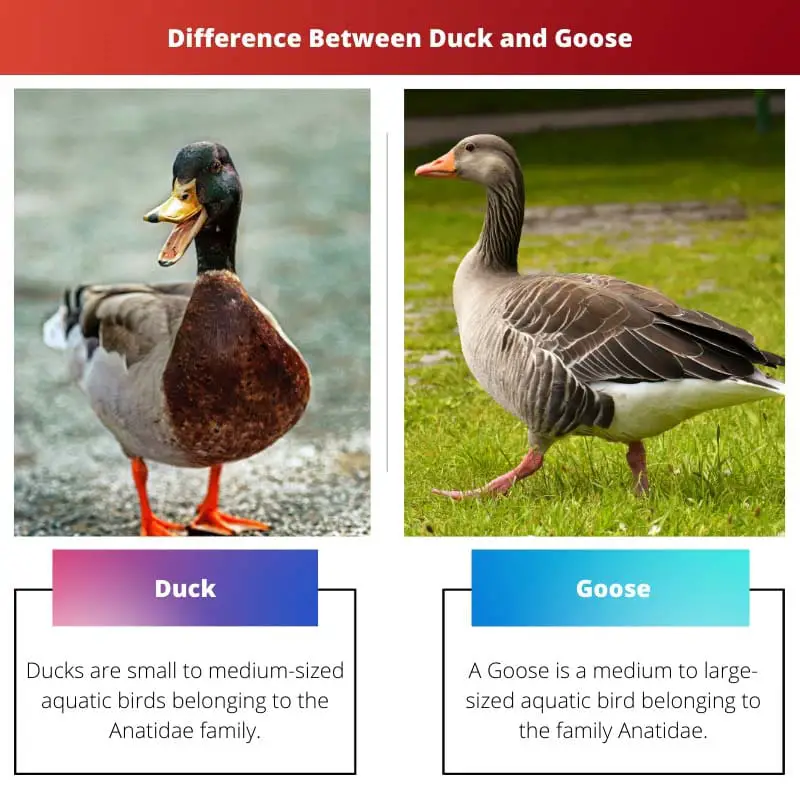Duck and Goose are nothing but waterbirds belonging to the same family of Anatidae. They are found inhabiting freshwater habitats like rivers, ponds, lakes, and oceanic islands.
Though both birds belong to the same family of Anatidae and have some common morphological features, they differ from each other in a lot of aspects.
Key Takeaways
- Ducks have a smaller body size; geese are larger and heavier.
- Ducks have a more diverse diet, including aquatic plants and insects; geese primarily graze on grass.
- Ducks have a distinct waddle when walking; geese exhibit a more upright posture and stride.
Duck vs Goose
A duck is a waterbird that has 16 or fewer bones in its neck. It has short legs, webbed feet, a waddling gait, and more colorful features. A goose is a larger waterbird with a longer neck. It has between 17 and 24 neck bones, short legs, webbed feet, and a short, broad bill.

Ducks are small-sized aquatic birds belonging to the Anatidae family. Along with Geese and Swans, Ducks are also waterfowls, and hence, inhabit near freshwater habitats like rivers, ponds, and lakes. They are omnivorous species feeding on small fishes, aquatic plants, and insects.
The goose is a medium to large-sized aquatic bird belonging to the Anatidae family. Their long neck and the absence of non-iridescent colors makes them unique from the other waterfowls.
Geese are herbivorous species feeding on grass. However, at times, they can also eat small insects and fish.
Comparison Table
| Parameters of Comparison | Duck | Goose |
|---|---|---|
| Physical Appearance | Has a stout body with shorter legs. | Has a longer neck, an elongated body, and long legs in comparison to that of a Duck. |
| Food | Ducks are omnivorous species feeding on small fishes, insects, and aquatic plants. | Goose is herbivorous and hence prefers feeding on small grass. |
| Feathers | Ducks have bright plumage. | Has white, grey, or black feathers, and lacks bright plumage. |
| Species | There are around 90 species of Ducks in the world. | There are around 29 species of Geese in the world, which is much smaller compared to Ducks. |
| Communication | Ducks make their significant ‘Quack’ sound to communicate with each other. | Geese don’t ‘Quack’ and communicate with each other by making a ‘honking’ sound. |
| Babies | Baby Ducks are known as ‘Ducklings’. | Baby Geese are known as ‘Goslings’. |
| Migration | Ducks do not migrate. | Geese are migratory birds. |
What is a Duck?
Ducks are small to medium-sized aquatic birds belonging to the Anatidae family. Ducks, along with Geese and Swans, are waterfowls and are hence, found inhabiting near water bodies like lakes.
Ducks have stout bodies with short legs and webbed feet and have shorter notched bills and low-positioned nostrils. Ducks are bright-feathered birds having orange, green, and yellow color feathers.
There are around 90 species of Ducks in the world and they are found in almost every part of the world except for Antarctica, which is too cold for them to survive. However, ducks are non-migratory birds and are found in a specific area.
Because of the quiet and calm nature of the Ducks, they take long hours to react to unfavorable surrounding noises or unwanted company. Ducks are farmed for their meat, feathers, and eggs.
They have a unique filtering system in their mouth which they use to filter water out of their beaks without losing any food.
Ducks are omnivorous species and prefer feeding on small fish, insects, and aquatic plants. They have a small breeding period and are monogamous, meaning they mate with one partner during the mating season.
Their lifespan ranges approximately between 7-10 years, and their predators include crocodiles, foxes, wolves, and humans.

What is a Goose?
A Goose is a medium to large-sized aquatic bird belonging to the family Anatidae. Their long neck and the absence of non-iridescent color makes them unique from the other waterfowls.
Geese are larger than Ducks and have long legs with more prominent webbed feet than Ducks. Geese lack bright plumage and have grey or white-colored feathers.
There are around 29 species of Geese around the world, found in Asia, North America, and Europe. They are migratory birds having extremely strong wings, which they use to cover long distances while migrating to warmer areas. They have an average lifespan of 10-15 years.
Geese are not calm and quiet birds like Ducks. They tend to flap their wings and make hissing noises to intimidate any unwanted company. Besides being farmed for their meat, eggs, and down feathers, Geese are frequently used in eliminating weed from the fields.
Their predators mostly include wolves, eagles, and foxes.
Geese are herbivorous species and prefer feeding on small grass. However, some of them can also eat small insects and fish. They have long breeding periods but lay only around 10-12 eggs during that period. Although Geese are monogamous, they form bonds that can last for a lifetime.

Main Difference Between Ducks and a Goose
- Ducks are small-sized aquatic birds with stout bodies and short legs, whereas Geese are medium to large-sized aquatic birds with elongated bodies and longer legs.
- Ducks are bright-feathered birds with orange, yellow, and black feathers, whereas Geese lack bright plumage and mostly have grey or white feathers. Geese are also covered with different spots.
- Ducks communicate with each other by making a significant ‘Quack’ sound. Geese, on the other hand, communicate with each other by making a loud ‘honking’ sound.
- Ducks have lesser neck bones than Geese, whereas Geese are known for their long necks.
- Ducks are omnivores and prefer feeding on small fishes, insects, and aquatic plants. Geese, on the other hand, are herbivores and prefer feeding on small grass.
- Ducks are non-migratory birds, whereas Goose is a migratory bird.
- Duck babies are known as ‘Ducklings,’ whereas Geese babies are known as ‘Goslings.’

- https://www.sciencedirect.com/science/article/pii/S1095643301005177
- https://www.sciencedirect.com/science/article/abs/pii/S0889157506001499

The comparison table is very helpful for understanding the contrasting characteristics of ducks and geese, such as their physical appearance, feathers, communication methods, and migratory habits.
I found the comparison table to be quite enlightening, offering a comprehensive breakdown of the differences between ducks and geese across various parameters.
Absolutely. The tabulated format facilitates a clear distinction between the key traits of ducks and geese, reinforcing the insights provided in the article.
The scholarly presentation of the differences between ducks and geese, encompassing their physical attributes, feathers, and migratory behaviors, offers readers an intellectually stimulating overview of these avian species, enhancing their knowledge.
I completely agree. The scholarly exposition provides a comprehensive delineation of the distinct characteristics and ecological behaviors of ducks and geese, fostering a scholarly understanding of these avian species.
The scholarly analysis of the differences between ducks and geese, elucidating their physical characteristics, dietary preferences, and communication methods, fosters a profound understanding of these waterfowl species, reflecting a commendable depth of insight.
I share the same viewpoint. The scholarly exposition of the contrasting features and ecological behaviors of ducks and geese contributes to an enriching comprehension of these waterbird species.
Absolutely. The insightful portrayal of the differences between ducks and geese offers readers a scholarly perspective on the distinct characteristics and behavioral patterns of these avian species, enhancing their knowledge.
The detailed descriptions of ducks and geese, along with their unique characteristics and habits, provide a thorough understanding of the two waterbird species. It’s commendable how the article delves into their differences from multiple perspectives.
I completely agree. The in-depth analysis contributes to a holistic comprehension of the distinctions between ducks and geese, encompassing aspects of their biology, behavior, and ecological roles.
The comprehensive analysis of the distinguishing features and behavioral attributes of ducks and geese offers readers a scholarly perspective on these avian species, enriching their knowledge and enhancing their understanding through a well-structured exposition.
I concur with your viewpoint. The scholarly overview offers an enlightening analysis of the distinct characteristics and behavioral patterns of ducks and geese, reflecting a commendable depth of insight.
Absolutely. The well-structured scholarly exposition of the contrasting traits and ecological behaviors of ducks and geese provides readers with a comprehensive understanding of these waterbird species.
The exhaustive information on the behavioral, ecological, and physical differentiations between ducks and geese contributes to a profound understanding of these waterfowl species, enabling readers to gain valuable insights.
Indeed, the comprehensive delineation of the attributes and behaviors of ducks and geese offers a scholarly perspective on these avian species, capturing the essence of their unique characteristics.
The scholarly depiction of the distinguishing traits and dietary inclinations of ducks and geese provides readers with a comprehensive understanding of these waterfowl species, reflecting a commendable depth of insight and scholarly rigor.
Indeed, the scholarly exposition of the distinctive characteristics of ducks and geese provides readers with a comprehensive understanding of these waterbird species, fostering a scholarly engagement with their ecological roles.
I concur with your perspective. The well-researched analysis of the contrasting features and ecological behaviors of ducks and geese offers an intellectually enriching perspective on these avian species.
The comprehensive portrayal of ducks and geese, from their physical attributes to their dietary preferences and migration patterns, enhances the reader’s knowledge about these waterfowls in a meticulous manner.
The article provides an erudite analysis of the differences between ducks and geese, shedding light on their distinctive traits and ecological behaviors with precision.
I share the same perspective. The detailed exploration of the various facets of ducks and geese offers an intellectually stimulating perspective on these avian species.
This article provides an insightful comparison between ducks and geese, focusing on their physical characteristics, habitat, diet, and behavioral differences. I appreciate the comprehensive overview.
Indeed, the detailed explanation brings clarity to the distinguishing attributes of ducks and geese, making it an enriching read.
I couldn’t agree more. This article offers a well-structured and informative analysis of the distinctive features and behaviors of ducks and geese.
The detailed account of the distinguishing features of ducks and geese, encompassing areas such as their physical appearance, feeding habits, and migratory behaviors, fosters a scholarly comprehension of these avian species through a well-organized exposition.
I concur with your assessment. The scholarly exposition of the contrasting traits and ecological behaviors of ducks and geese provides readers with a comprehensive understanding of these waterbird species.
Absolutely. The detailed portrayal of the distinct attributes and behavioral patterns of ducks and geese enriches the reader’s knowledge about these avian species, offering a scholarly overview of their ecological roles.